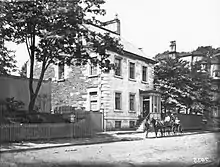Henry House (Halifax)
Henry House is a two-and-a-half-storey stone house located on Barrington Street in Halifax, Nova Scotia, Canada. The house is designated a National Historic Site,[1] and is both a Provincially Registered Property and a Municipally Registered Property under the provincial Heritage Property Act.[2][3]
| Henry House | |
|---|---|
 Henry House c. 1879 | |
 Location of Henry House in Nova Scotia | |
| General information | |
| Type | House |
| Address | 1222 Barrington Street Halifax, Nova Scotia B3J 1Y4 |
| Coordinates | 44°38′25″N 63°34′15″W |
| Current tenants | Henry House (restaurant) |
| Completed | 1834 |
| Official name | Henry House National Historic Site of Canada |
| Designated | 1969 |
| Type | Provincially Registered Property |
| Designated | 2005 |
| Type | Municipally Registered Property |
| Designated | 1981 |
History

The house was built in 1834 for John Metzler, a prosperous Halifax stonemason and landowner. It is primarily known for its association with William Alexander Henry, a prominent native of Halifax who resided here with his family from 1854-1864. Henry was a Father of Confederation, a co-author of the British North America Act, a provincial Attorney General,a Member of the Nova Scotia House of Assembly, a Mayor of Halifax and the first Nova Scotian to serve as a justice of the Supreme Court of Canada.[2]
The building served as a Sailors' Home in the late 19th and early 20th centuries, operated by the Navy League of Canada (Halifax Branch). In 1968 it was sold to Richard (Dick) Raymond and Jacques Ducau, who did extensive renovations and opened The Henry House(restaurant) and Little Stone Jug (downstairs tavern) in 1969. (The Stone Jug is slang for prison and was previously the namesake of a Halifax pub on Brunswick St. in the nineteenth century.[4][5][6][7])
Since then the well-known restaurant has been in continuous operation, and it is still called The Henry House Restaurant & Pub.
The Henry House was designated a National Historic Site in 1969.[1]
Architecture
Henry House has a gable roof, and has ashlar granite facades with ironstone on the gable ends. The architecture is generally representative of a typical style used in early 19th-century British North America for elite residences. In particular, it is an excellent example of the Halifax House style, a design brought to Nova Scotia by Scottish masons and characterized by three bays and a side hall plan.[3]
Mason's marks on the stone walls of Henry House:
References
- Henry House National Historic Site of Canada. Canadian Register of Historic Places. Retrieved 9 March 2013.
- Henry House (Provincially Registered Property). Canadian Register of Historic Places. Retrieved 9 March 2013.
- Henry House (Municipally Registered Property). Canadian Register of Historic Places. Retrieved 9 March 2013.
- Marines in the Revolution :a history of the Continental Marines in the American Revolution, 1775-1783, p. 352
- http://www.biographi.ca/en/bio/motton_robert_12E.html
- "Jugs" is slang for Irons. The Newgate Prison in London was referred to as a Stone Jug. (A Dictionary of Slang, Jargon & Cant Embracing English, American ..., Volume 2, edited by Albert Barrère, Charles Godfrey Leland)
- The Newgate Prison in Connecticut referred to the stone cellar under the guardroom as the Stone Jug (Newgate of Connecticut: Its Origin and Early History By Richard Harvey Phelps, p.70
See also
- List of oldest buildings and structures in Halifax, Nova Scotia
- List of historic places in the Halifax Regional Municipality
- List of National Historic Sites of Canada in Nova Scotia

